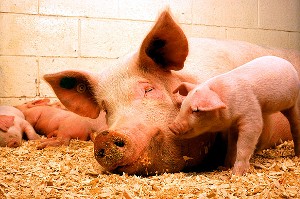Researchers from North Carolina State University in Raleigh, West Virginia University in Morgantown, and University of Maryland in College Park have developed a new technology that can lower harmful emissions from some chicken and swine barns, and reduce energy use by recovering heat. The authors published their findings in the December 2011 issue of the journal Applied Engineering in Agriculture (paid subscription required).
The research team designed and built a combination biofilter and a heat exchanger that reduces ammonia emissions from livestock barns, while also heating up the fresh air pumped into the barns. The biofilter reduces harmful ammonia emissions from livestock barns using organic, bacteria-laden media such as compost or wood chips. The bacteria interact with and break down the ammonia into less harmful components, including nitrogen that can be recycled into the soil to boost the soil’s potency.
Sanjay Shah, a professor of biological and agricultural engineering at NC State and lead author of the paper, says the research focused on ammonia removal because pig and chicken barns generate large quantities of the gas, which can lead to hypoxia, a condition that occurs under reduced oxygen concentrations. Ammonia is also an indirect contributor to greenhouse gases, as well as a precursor to fine particulate matter, itself a contributes to haze and public health problems such as asthma.
The biofiltration process, however, does not come without costs. The device has a heat-exchanger unit that extracts heat from the outside air to reduce the barn’s outside energy use, thus helping to offset the filtration costs. The unit also captures heat generated by the ammonia conversion process in the biofilter, reducing overall energy use even further. Keeping barns at warm temperatures helps in the rearing of chicks and piglets.
The team demonstrated their design under real-world conditions, operating the prototype in a 5,000-bird chicken house. The prototype removed up to 79 percent of ammonia and reduced the energy needed to maintain the necessary temperature in the facility, recovering as much as 8.3 kilowatts of heat.
“The technology is best suited for use when an operation wants to vent a facility that has high ammonia concentrations,” says Shah, “and pump in cleaner air in preparation for a fresh batch of chicks or piglets – particularly in cold weather.” In its current state, however, the technology is not compatible with summer ventilation using tunnel-fans, Shah adds, because of the high cost and choking effect on the fans.
“We plan to continue working to improve the system design in order to make it even more efficient,” Shah says.
Read more: Mobile Lab to Test Environmental Impact of Farms
* * *


 RSS - Posts
RSS - Posts
You must be logged in to post a comment.